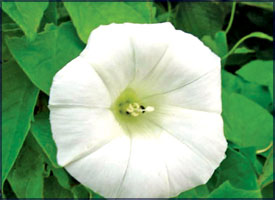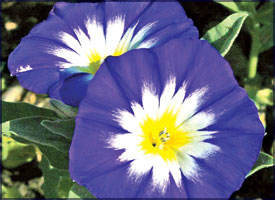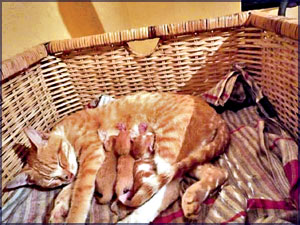|
Flowers & pets |
- Compiled
by Damayanthi Hewamanna |
Convolvulus and the Calystegia
Convolvulus is a genus of about 250 species of flowering plants in
the bindweed family Convolvulaceae, with a cosmopolitan distribution.
Common names include bindweed and morning glory, both names shared with
other closely related genera.
|

Calystegia sepium |
|

Calystegia soldanella |
|

Calystegia |
| |
|

Convolvulus galaticus |
|

Convolvulus - Blue Enchantment |
|

Two convolvulusI |
They are annual or perennial herbaceous vines and woody shrubs,
growing to 0.3-3 m tall. The leaves are spirally arranged, and the
flowers trumpet-shaped, mostly white or pink, but blue, violet, purple
or yellow in some species.
Many of the species are problematic weeds, which can swamp other more
valuable plants by climbing over them, but some are also deliberately
grown for their attractive flowers. However, some other species are
globally threatened. This species occurs in many temperate regions. They
are mostly slender, creeping winding vines. A few are small perennials.
They have simple, alternate leaves and wide funnel-shaped flowers.
Convolvulus species are used as food plants by the larvae of some
Lepidoptera species including the leaf-miner Bucculatrix cantabricella
(feeds exclusively on Convolvulus cantabricus), Bedellia annuligera
(recorded on Convolvulus arvensis) and Bedellia somnulentella.
Calystegia is a genus of about 25 species of flowering plants also in
the bindweed family of Convolvulaceae. They are annual or herbaceous
perennial twining vines growing to 1-5m tall, with spirally arranged
leaves. The flowers are trumpet shaped, 3-10 cm diameter, white or pink,
with a sometimes inflated basal calyx.
The genus bears much similarity to a related genus Convolvulus, and
is sometimes combined with it and is distinguished primarily by the
pollen being smooth, and in the ovary being unilocular.
Some of the species, notably silvatica, are problematic weeds, which
can swamp other more valuable plants by climbing over them, but some are
also deliberately grown for their attractive flowers.
Calystegia species are used as food plants by the larvae of some
Lepidoptera species including Bedellia somnulentella and Small Angle
Shades.
The name is derived from two Greek words kalux, (cup) and stegos, (a
covering), meaning ‘a covering cup’.
The stem is creeps over the ground not winding and the leaves are
dark green and reniform. The petioles are ovate or elliptical. The
corolla is pink or pale purplish, with 5 white stripes.
****
Kingdom : Plantae
(unranked) : Angiosperms
(unranked) : Eudicots
(unranked) : Asterids
Order
: Solanales
Family : Convolvulaceae
Genus : Convolvulus/
Calystegia
****
A Cats Life
Cats are known to be the proudest, neatest, and most worshipped (in
their world), creatures in the world and who also lead the royal line in
the jungle. The cat (Felis catus), also known as the domestic cat or
house cat is a small predatory carnivorous species of crepuscular mammal
that is valued by humans for its companionship and its ability to hunt
vermin, snakes, scorpions and other unwanted household pests. It has
been associated with humans for at least 9,500 years.
|

Always by Buttons side except when mumma wants time on her own |
A skilled predator, the cat is known to hunt over 1,000 species for
food and can be trained to obey simple commands. Individual cats have
also been known to learn on their own to manipulate simple mechanisms,
such as doorknobs and toilet handles. Cats use a variety of
vocalizations and types of body language for communication, including
meowing, purring, hissing, growling, squeaking, chirping, clicking, and
grunting.
Cats have been kept by humans since at least ancient Egypt, where
Bast in cat form was goddess of the home, the domesticated cat,
protector of the fields and home from vermin infestations, and sometimes
took on the warlike aspect of a lioness. The first domesticated cats may
have saved early Egyptians from many rodent infestations and likewise,
Bast developed from the adoration for her feline companions.
She was the daughter of the sun god Ra and played significant role in
Ancient Egyptian religion. It has been speculated that cats resident in
Kenya’s Islands in the Lamu Archipelago may be the last living direct
descendants of the cats of ancient Egypt.
Several ancient religions believed that cats are exalted souls,
companions or guides for humans, that they are all-knowing but are mute
so they cannot influence decisions made by humans. In Japan, the Maneki
Neko is a cat that is a symbol of “good fortune”. Although there are no
sacred species in Islam, it is said by some writers that Muhammad had a
favourite cat, Muezza. It is said he loved cats so much that “he would
do without his cloak rather than disturb one that was sleeping on it”.
Cats are known for their fastidious cleanliness. They groom
themselves by licking their fur, employing their hooked papillae and
saliva. As mentioned, their saliva is a powerful cleaning agent and
deodorant. Many cats also enjoy grooming humans or other cats. Sometimes
the act of grooming another cat is initiated as an assertion of superior
position in the pecking order of a group (dominance grooming).
Some cats occasionally regurgitate hairballs of fur that have
collected in their stomachs as a result of their grooming. Longhaired
cats are more prone to this than short-haired cats. Hairballs can be
prevented with certain cat foods and remedies that ease elimination of
the hair, and regular grooming of the coat with a comb or stiff brush.
Indoor cats are usually provided with a litter box containing litter,
typically bentonite, but sometimes other absorbent material such as
shredded paper or wood chips, or sometimes sand or similar material.
This arrangement serves the same purpose as a toilet for humans. It
should be cleaned daily and changed often, depending on the number of
cats in a household and the type of litter; if it is not kept clean, a
cat may be fastidious enough to find other locations in the house for
urination or defecation.
This may also happen for other reasons; for instance, if a cat
becomes constipated and defecation is uncomfortable, it may associate
the discomfort with the litter box and avoid it in favour of another
location. A litter box is recommended for indoor-outdoor cats as well.
|

Ginger, Buttons and Pookit suckling away |

Buttons, Ginger and Pookit |
Allergic reactions to cat dander or cat saliva inspire one of the
most common reasons people cite for disliking cats. Some humans who are
allergic to cats, typically manifested by hay fever, asthma or a skin
rash, quickly acclimate themselves to a particular animal and live
comfortably in the same house with it, while retaining an allergy to
cats in general. However, this should not be depended upon.
Many humans find the rewards of cat companionship outweigh the
discomfort and problems associated with these allergens.
Some cope with the problem by taking prescription allergy medicine,
along with bathing their cats frequently (weekly bathing will eliminate
about 90 percent of the cat dander present in the environment). There
are also attempts to breed cats that are less likely to provoke an
allergic reaction.
According to a myth in many cultures, cats have nine (or sometimes
seven) lives. The myth is attributed to the natural suppleness and
swiftness cats’ exhibit to escape life-threatening situations. Also
lending credence to this myth is that falling cats often land on their
feet because of an in built automatic twisting reaction and are able to
twist their bodies around to land feet first, though they can still be
injured or killed by a high fall.
Source:Wikipedia
Cat Tips
* Unlike dogs and children, cats are unlikely to come to you just
because you want them to obey. However, a cat who knows he will be
warmly petted, brushed, will receive a treat, or an extended period of
lap-napping, is more likely to get up, stretch, look casually around,
and then wander over to you (displaying, for all intents and purposes,
the attitude that it was his idea in the first place). No animal will
come to you willingly if you are raising your voice or if they think
they are going to be punished.
* Cats, by the way, respond best to names that end in an “ee” sound.
You will most likely get a better response if you shorten Prince Zadrach
of Dominquez’ name to Zaddy, for example. Too, they seem to respond
better to a higher-pitched tone of voice.
* Scratching furniture/declawing first, please note that declawing
your cat so he won’t scratch your furniture is cruel and inhumane. You
should train your cat to use a scratching post. Other alternatives
include a quick, painless trimming of his claws (which you can do at
home using special clippers).
* Scratching is one of your cat’s most ingrained instincts. Keep a
scratching post near where the cat usually sleeps or, if he has already
picked out a corner of your sofa, keep it next to that chosen spot.
You may need to train your cat to use his scratching post. Do not
pick him up and put his paws on the scratching post (that will only make
him want to avoid it).
Make the scratching post appealing to him: rub catnip on it or mist
it with catnip spray; drape a heavy string (a long leather shoelace
works great) over it and wiggle it to catch his interest; put treats on
the very top.
----------------******
Please send in your
contributions to [email protected] or
[email protected]
The Associated
Newspapers of Ceylon Ltd., at No. 35,
D.R.Wijewardene Mawatha, Colombo 10
----------------***** |



